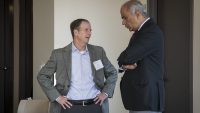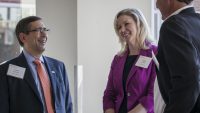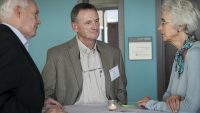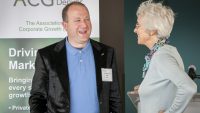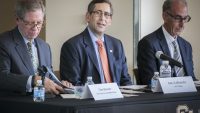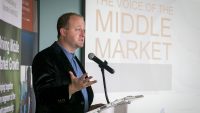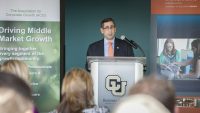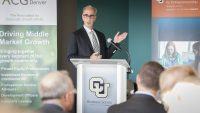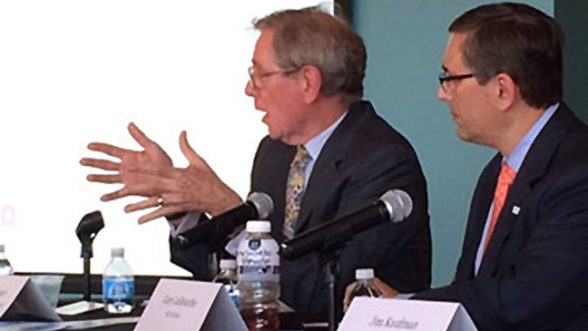
Panel says sector is a powerhouse in U.S. economy, but often gets overlooked
Like the middle child in a family, mid-sized businesses are the oft-overlooked sector of the economy.
But middle market businesses—companies with annual revenues of $10 million to $1 billion—are the main driver of the U.S. economy and this year will produce about 60 percent of all new jobs.
The Jake Jabs Center for Entrepreneurship at the CU Denver Business School shined light on this important sector at a panel discussion on “The Voice of the Middle Market” on Tuesday. The forum was also sponsored by the Association for Corporate Growth (ACG) Denver and the National Center for the Middle Market. About 60 people attended the event in the Laube Commons.
Business School Dean Sueann Ambron welcomed the audience, noting that “These days, as many of you know, Denver is a red-hot startup place. These companies, when they’re successful, will join this middle market group, and that is very much a positive.”
U.S. Rep. Jared Polis, D-Boulder, whose 2nd District includes Boulder and Fort Collins, joining Denver as among the hottest business startup cities in the nation, delivered opening remarks. The panel included Tony Stewart, executive director of the National Center for the Middle Market; Gary LaBranche, president and CEO of ACG Global; and James Kaufman, managing member of Mogul Advisors.
Polis said he recently formed the Congressional Caucus for Middle Market Growth, which aims to give mid-sized businesses a voice in the public sphere and in Washington, D.C. “Too often middle market companies simply don’t have the same kind of resources that big businesses have, nor the attention that is associated with small businesses,” Polis said. “So they have heretofore lacked a real strong and cohesive voice to shape policies of interest that benefit the entire community.”
Stewart shared data collected from the National Center for Middle Market Research to provide a detailed portrait of the sector. “The middle market represents 3 percent of all companies nationwide, but one-third of GDP and $10 trillion in annual revenue,” he said. “If it was an economy on its own it would be bigger than Germany.”
He said the sector’s 6.6 percent revenue growth in the past 12 months, and 3.2 percent employment growth, is double the pace of the rest of the U.S. economy. “The revenue growth is nearly double that of the S&P 500, so if you want to see organic growth you look for it in the middle market,” Stewart added.
In the western U.S., mid-sized companies have seen 7.2 percent revenue growth and 3.3 percent employment gains in the past 12 months. In Polis’s district, the sector accounts for 221 companies employing 80,000 people.
The panelists noted that middle market businesses tend to be customer-centric, conservative financially and less globally oriented than larger firms. About 85 percent of the companies are privately held.
LaBranche said the middle market grows jobs faster than any other sector, but needs to ramp up awareness of its power. “It’s often easy to overlook, but the middle market has not approached Congress and the regulatory agencies with a singular focus,” he said. “If you’re not at the table, you’re what’s for lunch.”
During the Q&A session, an audience member asked how mid-sized companies can expand globally when they tend to be financially conservative. Kaufman pointed out that there are low-risk ways for companies to expand. “If you have a good product or service, people from abroad are going to come knocking at your door. … It can be relatively easy to find foreign partners and develop networks there.”
Listening in the audience was Hugh Ferdows, PhD, chairman and CEO of Sutrak, a firm that manufactures transport refrigeration and air conditioning for buses, rail lines and motor homes. Ferdows founded the company in Germany and moved to the U.S. 34 years ago. The Sutrak factory in Denver manufactures cooling systems for transit systems across the nation and globe.
He knows something about being overlooked. With a chuckle, Ferdows said, “We ship everywhere in the U.S. and everywhere in the world—except Denver.”
He said Sutrak used to provide AC units for all of Denver’s RTD buses, but that all changed abruptly about 20 years ago. “One day, we had all the transportation here, but then everything changed due to politics,” he said.


